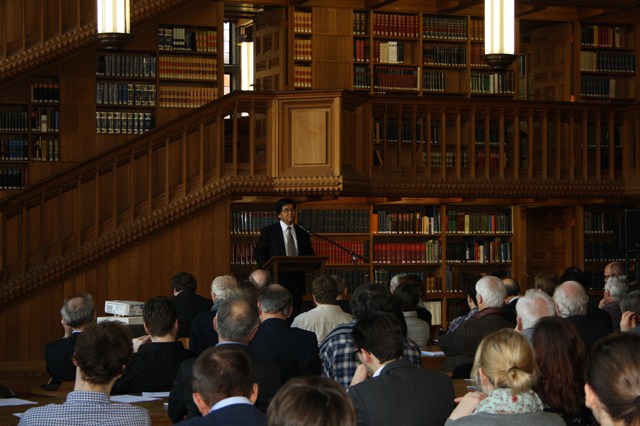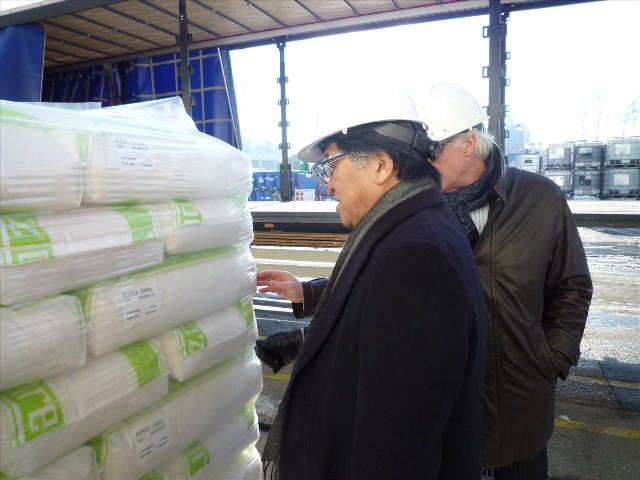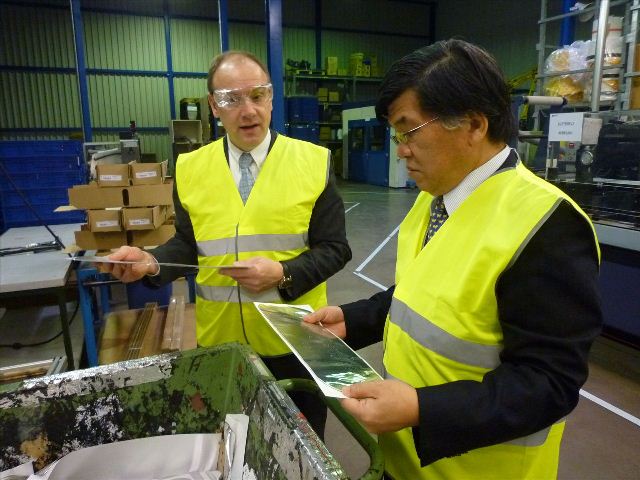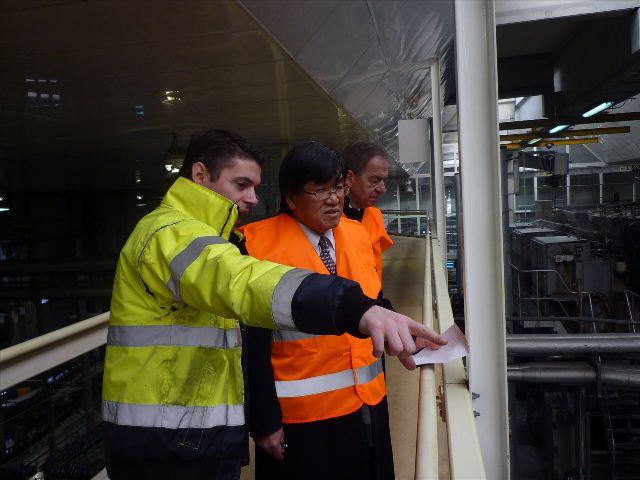|
West Flanders and Limburg (No.12)
March 22nd, 2013
Together with springtime, the season of the Queen Elisabeth International Music Competition has arrived. This competition is one of the three biggest competitions worldwide as a gateway to success in the world of classical music. There are four categories, for piano, violin, voice and composition. This year’s competition is the three-yearly piano competition. The other day, the Competition Office announced the names of the 75 candidates, among which 8 Japanese, for the first qualifying round. As the number of applicants reached a record high of 283, the pass rate for the pre-screening was one out of 3.8 on the basis of DVD’s. What is surprising is that out of the 75 candidates, 17 are South Koreans and 9 are Chinese, which means that only 3 countries including Japan make up for nearly half of the candidates. East Asia seems to become more and more influential in the field of classical music. Well, the first public qualifying round starts on May 6th. I hope that the young musicians from Japan will do their best.
< Two Mayors in Flanders >
The other day I visited West Flanders, Belgium’s westernmost province, to pay a courtesy call to two mayors. The first one was Mr Renaat Landuyt, mayor of Bruges (117.000 inhabitants). He belongs to the socialist party and has just been appointed mayor this January. Mr Landuyt has a long political career serving as Vice-Minister-President of the Flemish Government and Minister of Mobility in the Federal Government before. I signed for the visit in the mayor’s presence in the town hall and had the opportunity to have an informal talk for a short while. When I mentioned that 170.000 Japanese tourists visit Bruges annually, the mayor told me that recently it is popular for Japanese young newlywed couples to have again a wedding ceremony in the 14th century “Gothic Hall” to take souvenir pictures. At the end, he told me that he would like to invite me as a guest of honour to the “Procession of the Holy Blood” on the 9th of May and I replied that I would gladly accept his invitation. This event takes place every year on Ascension Day and is a magnificent procession. Groups dressed like medieval knights carry the “Relic of the Holy Blood” around the city. It is said that the Count of Flanders brought the relic back from Jerusalem in the Second Crusade in the 12th century. I look already forward to it.
The second mayor I met was Mr Jan Durnez, mayor of Ypres (35.000 inhabitants). As introduced in Ambassador’s Chat No. 1, the city of Ypres is known as the site of a bloody battle in World War I, and the mayor himself guided me through the War Memorial Museum (renovated last June). After serving as a senator in the federal government until last year, Mr Durnez was elected as communal counsellor, but because Mr Yves Leterme, who was elected mayor, continues to work as Deputy Secretary-General of the Organization for Economic Co-operation and Development (OECD) in Paris, Mr Durnez is the acting mayor for the time being. As the system is different from that of Japan, it is a little difficult to understand. A big toy cat wearing a knight’s armour is placed at the town hall’s entrance informing us all of a sudden that Ypres is the ”Cat’s City”. I got a toy cat as a souvenir from the mayor and was invited to the “Cat Festival”. However, this event is held every three years and the next Cat Parade will take place in 2015. Well, I wonder if I will still be working in Belgium by then.
< Catholic University of Leuven and the College of Europe >
 The other day I was asked by the Catholic University of Leuven (cfr. Ambassador’s Chat No. 3), located about 30 km to the east of Brussels, to give a lecture. I talked for about 45 minutes about the “Challenges for Japan in the 21st Century” to an audience of nearly 300 people, both professors and students, and I responded to the subsequent question and answer session. From the audience’s questions I felt a strong interest in Japan: how is the reconstruction of the affected areas 2 years after the Great East Japan earthquake and the nuclear accident, what will be the energy policy on nuclear power, etc. Also, there were questions about how Japan’s foreign policy and economic and monetary policy would be changed by the new Abe administration that came to power at the end of last year. As future challenges for Japan, I also addressed the issues of the aging society and the creation of a new value system for the post-industrial era. Actually, I got a request for an interview from the editorial department of the university newspaper (9000 printed copies) last week and because the contents of this interview were published in an article at the beginning of this week, many people knew already the key points of my talk before the lecture. This kind of project is very meaningful. The other day I was asked by the Catholic University of Leuven (cfr. Ambassador’s Chat No. 3), located about 30 km to the east of Brussels, to give a lecture. I talked for about 45 minutes about the “Challenges for Japan in the 21st Century” to an audience of nearly 300 people, both professors and students, and I responded to the subsequent question and answer session. From the audience’s questions I felt a strong interest in Japan: how is the reconstruction of the affected areas 2 years after the Great East Japan earthquake and the nuclear accident, what will be the energy policy on nuclear power, etc. Also, there were questions about how Japan’s foreign policy and economic and monetary policy would be changed by the new Abe administration that came to power at the end of last year. As future challenges for Japan, I also addressed the issues of the aging society and the creation of a new value system for the post-industrial era. Actually, I got a request for an interview from the editorial department of the university newspaper (9000 printed copies) last week and because the contents of this interview were published in an article at the beginning of this week, many people knew already the key points of my talk before the lecture. This kind of project is very meaningful.
On the occasion of my above-mentioned visit to Bruges, I also visited the College of Europe. This college is a specialized school offering a one-year program for education and research about the unification of Europe. There are 322 students (120 students for the Poland campus) from 55 different countries of origin, but mainly from European countries such as France, UK and Germany. As for the Asian students this year, there are only 2 Chinese students, but in the past they have also had Japanese students. Rector Paul Demaret himself visited Japan last year and voiced the intention to increase the number of Asian students. Almost half of the college’s operating costs are covered by subsidies from the EU budget and by subsidies from both the Belgian federal and regional governments. The remaining half matches the student’s tuition fees. The tuition fees of 22.000€ per year are high, but there’s a boarding system and many of the students seem to receive a scholarship. Many graduates become EU officials, government officials or politicians. The current Prime Minister of Denmark, Helle Thorning-Schmidt, is also one of the alumni. It is indeed a great human network of friends who have lived under the same roof for one year and who have scattered across the European countries taking up important positions.
< Company Visit No. 7: Japanese Companies in Limburg >
 Last week, I visited two Japanese companies in Genk (65.000 inhabitants), 100 km east of Brussels, in the province of Limburg. Limburg is situated on the border with the Netherlands to the north and east and Germany is only a 30-minute drive away. Including as well the area around the provincial capital Hasselt, a dozen Japanese companies are active in Limburg. My first visit was to Sumitomo Bakelite Europe where 140 employees out of 230 work at the factory in Genk. The factory itself has a history of nearly 50 years, but the acquisition by Sumitomo Bakelite was in 2000 and the company has been operating under the current name since 2004. They manufacture phenolic resins mainly used in fixatives for car tires, but it is also used as a material in various plastic products. In 2005, this company acquired a factory in the western suburbs of Gent and it seems to be expanding its sales market all over Europe. Phenolic resins were invented at the outset of the 20th century by Doctor Leo Baekeland, a Belgian born American, so it is a curious coincidence that a Japanese company produces and sells it in Belgium 100 years later. Last week, I visited two Japanese companies in Genk (65.000 inhabitants), 100 km east of Brussels, in the province of Limburg. Limburg is situated on the border with the Netherlands to the north and east and Germany is only a 30-minute drive away. Including as well the area around the provincial capital Hasselt, a dozen Japanese companies are active in Limburg. My first visit was to Sumitomo Bakelite Europe where 140 employees out of 230 work at the factory in Genk. The factory itself has a history of nearly 50 years, but the acquisition by Sumitomo Bakelite was in 2000 and the company has been operating under the current name since 2004. They manufacture phenolic resins mainly used in fixatives for car tires, but it is also used as a material in various plastic products. In 2005, this company acquired a factory in the western suburbs of Gent and it seems to be expanding its sales market all over Europe. Phenolic resins were invented at the outset of the 20th century by Doctor Leo Baekeland, a Belgian born American, so it is a curious coincidence that a Japanese company produces and sells it in Belgium 100 years later.
 The next visit was to Nitto Europe, a company with factories in Genk and Istanbul. Since the start in 1974, mainly industrial tape for the protection of metal plates is manufactured at the factory in Genk (650 employees). The sales result in Europe (2011) amounted to 176 million euro and the market share was at 5 to 7%. Parent company, Nitto Denko Corporation, has expanded their business mainly in Asia (especially China) since its establishment in 1918. Nitto Denko Co. has now 107 companies all over the world and has grown into a big company boasting total annual sales of 5.5 billion euro. The American 3M and German and French companies are monopolizing the market in Europe, but I hope that Nitto Europe will expand their share. The next visit was to Nitto Europe, a company with factories in Genk and Istanbul. Since the start in 1974, mainly industrial tape for the protection of metal plates is manufactured at the factory in Genk (650 employees). The sales result in Europe (2011) amounted to 176 million euro and the market share was at 5 to 7%. Parent company, Nitto Denko Corporation, has expanded their business mainly in Asia (especially China) since its establishment in 1918. Nitto Denko Co. has now 107 companies all over the world and has grown into a big company boasting total annual sales of 5.5 billion euro. The American 3M and German and French companies are monopolizing the market in Europe, but I hope that Nitto Europe will expand their share.
< Belgium’s Number Two Brewer >
 Speaking of Belgium, beer comes to mind first, but one does not often have the chance to see the manufacturing site. On the occasion of my visit to the province of Limburg, I requested a factory visit to Alken-Maes because it is close to Hasselt. With a market share of 12% Alken-Maes is Belgium’s second biggest brewer. The company (500 employees) has 3 breweries in Belgium and in the beer factory in Alken 1.4 million hectolitres of beer (560 million pints of beer) is brewed per year by 140 employees. The fully automated bottling process with a production capacity of 120.000 small bottles per hour is a spectacular scene. 27 kinds of products are produced by 10 brand names among which the well-known names of Cristal, Affligem and Mort Subite. The beer factory in this area was first set up in 1923 and became Alken-Maes through the merger of companies in 1988. However, in recent years, while the beer consumption in Belgium is declining significantly, the weeding-out in the industry is progressing rapidly and Alken-Maes as well joined the Dutch Heineken in 2008. The headquarters too have moved to Mechelen, closer to the Dutch border. The Belgian beer export has been growing steadily, but the struggle for survival by fusion and fragmentation among the domestic manufacturers becomes tougher and tougher. Speaking of Belgium, beer comes to mind first, but one does not often have the chance to see the manufacturing site. On the occasion of my visit to the province of Limburg, I requested a factory visit to Alken-Maes because it is close to Hasselt. With a market share of 12% Alken-Maes is Belgium’s second biggest brewer. The company (500 employees) has 3 breweries in Belgium and in the beer factory in Alken 1.4 million hectolitres of beer (560 million pints of beer) is brewed per year by 140 employees. The fully automated bottling process with a production capacity of 120.000 small bottles per hour is a spectacular scene. 27 kinds of products are produced by 10 brand names among which the well-known names of Cristal, Affligem and Mort Subite. The beer factory in this area was first set up in 1923 and became Alken-Maes through the merger of companies in 1988. However, in recent years, while the beer consumption in Belgium is declining significantly, the weeding-out in the industry is progressing rapidly and Alken-Maes as well joined the Dutch Heineken in 2008. The headquarters too have moved to Mechelen, closer to the Dutch border. The Belgian beer export has been growing steadily, but the struggle for survival by fusion and fragmentation among the domestic manufacturers becomes tougher and tougher.
|

